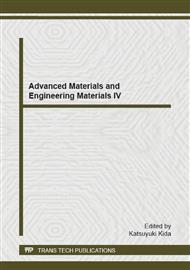[1]
J.G. Wang, G.R. Liu, On the optimal shape parameters of radial basis functions used for 2-D meshless methods, Computer Methods in Applied Mechanics and Engineering. 191 (2002) 2611-2630.
DOI: 10.1016/s0045-7825(01)00419-4
Google Scholar
[2]
A.H.D. Cheng, M.A. Golberg, E.J. Kansa, Q. Zammito, Exponential convergence and h - c multiquadric collocation method for partial differential equations, Numerical Methods for Partial Differential Equations. 19 (2003) 571–594.
DOI: 10.1002/num.10062
Google Scholar
[3]
A.J.M. Ferreira, G.E. Fasshauer, R.C. Batra, J.D. Rodrigues, Static deformations and vibration analysis of composite and sandwich plates using a layerwise theory and RBF-PS discretizations with optimal shape parameter, Composite Structures. 86 (2008).
DOI: 10.1016/j.compstruct.2008.07.025
Google Scholar
[4]
E.J. Kansa, R.C. Aldredge, L. Ling, Numerical simulation of two-dimensional combustion using mesh-free methods, Engineering Analysis with Boundary Elements. 33 (2009) 940–950.
DOI: 10.1016/j.enganabound.2009.02.008
Google Scholar
[5]
E.J. Kansa, Y.C. Hon, Circumventing the ill-conditioning problem with multiquadric radial basis functions: applications to elliptic partial differential equations, Computers and Mathematics with Applications. 39 (2000) 123-137.
DOI: 10.1016/s0898-1221(00)00071-7
Google Scholar
[6]
J. Wertz, E.J. Kansa, L. Ling, The role of the multiquadric shape parameters in solving elliptic partial differential equations, Computers and Mathematics with Applications. 51 (2006) 1335–1348.
DOI: 10.1016/j.camwa.2006.04.009
Google Scholar
[7]
S.A. Sarra, D. Sturgill, A random variable shape parameter strategy for radial basis function approximation methods, Engineering Analysis with Boundary Elements. 33 (2009) 1239–1245.
DOI: 10.1016/j.enganabound.2009.07.003
Google Scholar
[8]
A.J.M. Ferreira, C.M.C. Roque, P.A.L.S. Martins, Analysis of composite plates using higher-order shear deformation theory and a finite point formulation based on the multiquadric radial basis function method, Compos: Part B. 34 (2003) 627–636.
DOI: 10.1016/s1359-8368(03)00083-0
Google Scholar
[9]
S. Xiang, K.M. Wang, Free vibration analysis of symmetric laminated composite plates by trigonometric shear deformation theory and inverse multiquadric RBF, Thin-Walled Structures. 47 (2009) 304–310.
DOI: 10.1016/j.tws.2008.07.007
Google Scholar
[10]
J.N. Reddy, Mechanics of Laminated Composite Plates Theory and Analysis, CRC Press, Boca Raton, (1997).
Google Scholar


